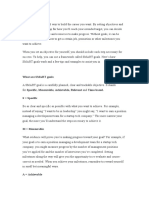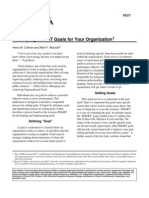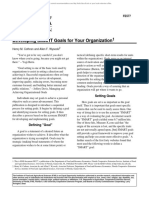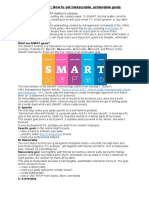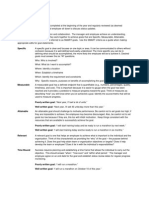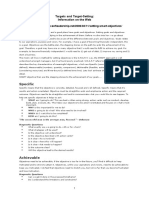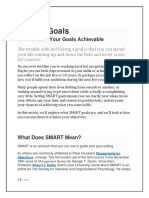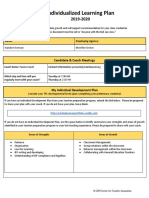Setting Goals
In Lewis Carrol’s “Alice in Wonderland,” Alice had the following exchange with the Cheshire Cat.
"Would you tell me, please, which way I ought to go from here?"
"That depends a good deal on where you want to get to," said the Cat.
"I don't much care where—" said Alice.
"Then it doesn't matter which way you go," said the Cat.
"—so long as I get SOMEWHERE," Alice added as an explanation.
"Oh, you're sure to do that," said the Cat, "if you only walk long enough."
The meaning in this conversation perfectly describes the outcome of not having goals. It is quite
possible to exist without goals. This floating through life approach is the practical outcome for most of
our population. This is not to say that people do not have dreams or aspirations, only that without goals
and a plan to complete them our dreams and aspirations remain just that. Even those statements we
believe to be goals are frequently only wishful thinking when they are not backed up with a
commitment and plan for completing them. While it is possible to achieve great success without a plan,
the chances are much improved when a deliberate process of setting goals is used. This is particularly
true for the Engineer whose work world is filled with generating tangible work products usually on a
fixed timeline. The setting of SMART goals uses the analytical problem solving process that is most
familiar to Engineers, and thus should be a key tool in their kit.
Here, I will describe the steps to produce SMART goals. This acronym provides some, but not all of the
key elements of setting a meaningful and achievable goal. Let’s begin with the meaning of the acronym.
Over the years, I have seen different versions of the acronym, but will use the following definitions here.
S – Specific. The goal must not be too broad. For a goal that is too broad, it is difficult to monitor
progress or to align with the goals of higher level managers and the organization.
M – Measurable. The goal must be stated in such a way that it is quantifiable. It is very difficult to know
when a goal is complete if it is not measurable.
A – Achievable. If a goal is stated in such a way that it is extraordinarily broad or large, then establishing
a meaningful timeline and generating commitment may prove very difficult. For the most part, goals as
used in this course have a modest timeline ranging from 6 months to 2 years. Unusually large goals may
have to be broken down into smaller pieces.
R – Relevant. Setting a goal for the sole purpose of setting a goal carries little meaning. In order for a
goal to be relevant, it must be tied in some clearly understood way to a personal or organizational vision
or strategy. This is the point of connection between goals and aspirations. Good alignment between
personal goals and aspirations is fundamentally important to success and to personal fulfillment and
happiness.
T- Time Bound. The healthy tension created by setting timelines for accomplishing actions is the key
driving force behind achieving success through setting good goals. Awareness of the time constraints
reinforces the commitment to action. It is also a key to prioritization of personal activities.
�In addition to the above description of what constitutes a SMART goal, I believe there are two other
keys to effective implementation of a SMART goal. First, the goal must be divided into smaller actions
which must be arrayed in time in a parallel or series manner. In this regard, setting up a good goal
closely resembles project management principles. Only with a coherent array of series and parallel
actions in place can appropriate time boundaries be set. The sum of the key steps to be undertaken that
result in the longest time to overall accomplishment becomes the “critical path,” just as in a project.
However, even a well-crafted SMART goal complete with relevant action steps is meaningless unless
there is an identified and agreed upon basis for resourcing the goal. In the case of personal goals, are
you willing to spend the time and money it takes to complete the goal? If not, then there is no goal. In
the case of a business or job related goal, is your manager willing to commit the resources to get the
goal completed? If not, the goal cannot be achieved, and it is time to renegotiate the goal. I have
always viewed the acceptance of a job related goal by both the employee and supervisor as an implied
contract to resource the goal as needed. Even better though is that you have the resourcing
conversation along with the goal setting one. This helps insure that the “Relevance” and “Achievable”
conditions are met.
It is helpful in setting goals to adopt an “internal locus of control.” By this, I mean that it involves
personal ownership, commitment, and action. A well-stated goal will be action oriented, and will use
active voice is its form. It is not “something will happen,” it will be “I will cause something.” So, we
begin the formulation of a goal with the statement of the objective. An objective is a statement of the
who, what, and why portions of the goal. These three components combine to yield a “clarified
objective.” It should be obvious that the “who” is you in your goals. The “what” portion of the objective
contains an action verb along with a topic. The following are examples:
Design a distillation column retrofit…..
Estimate the cost of installing a new pump….
Prepare a project plan….
The objective statement is completed by adding clarifying information that provides the answer to
“why.” Using the above examples, the clarified objective statements, complete with the “who” portion
might look like the following:
I will design a distillation column retrofit that will increase capacity.
I will estimate the cost of installing a new pump to overcome capacity limitations.
I will prepare a project plan for installing a new process control system.
We are now ready to add the measures and timing needed to convert these objectives into meaningful
goals. The quantification of the objective is an essential step in determining feasibility. When possible,
the quantification should use historical data from similar types of objectives/goals as a way to
benchmark probability of success as well. A goal cannot be reliably tracked unless it is measureable.
Lastly, the time boundaries must be set in order to instill a sense of urgency that will facilitate a drive
�towards completion. Unbounded goals have no urgency, and thus have lower commitment. Having
time boundaries forces the need for discipline in planning and executing the goal in a world of
competing priorities. Using the examples above, SMART goals for the objectives might look like the
following:
I will design a distillation column retrofit within the next three months that will increase capacity by
10%.
I will estimate the cost of installing a new pump to overcome capacity limitations within two months to
improve throughput by 25%.
I will prepare a project plan for installing a new process control system during the next quarter that will
reduce process variability by 5%.
Once SMART goals are fully stated, they must be augmented with a detailed action plan that includes
the resources needed for accomplishment. This augmentation is frequently overlooked in the
development of goals. Committing to a goal without an action plan carries with it the high risk of failure.
The action plan is the array of tasks to be completed in either series or parallel fashion along a timeline
that matches the overall time boundaries of the goal statement. Resources include money, facilities,
people, and equipment needed to carry out the goal. Once all of these elements are developed, they
can be written in a logical form using the attached template. While this template may not fit the normal
goal recording form that you use in your organization, it can help you insure that all of the critical
elements are considered. You should consider using the form for backing up whatever other system you
currently have. It can also provide a good format for discussing your goals with your supervisor or
manager in such a way that you can get agreement on the goal as well as the commitment to provide
needed resources. It also provides a convenient objective tool for assessing the completion of the goal
at the appropriate time, including during your performance assessment.
Setting meaningful goals is hard work. It should be given focused attention, as your goals will in many
ways define your success not only as an engineer, but also as a leader. Having the discipline to
formulate SMART goals will make you a stronger and more effective engineer, and as a leader will help
you develop your staff much more professionally.


